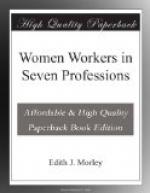(2) The other factor has been the public spirit of the medical women concerned, without which nothing could have been done. One of the forms of public service most essential at the present day and for which the individual gets neither honour nor even thanks, is that of refusing “black leg” labour. It is generally admitted by those who have to deal with the question of salaries and conditions of work under public authorities, that medical women, as a whole, have shown at least as great public spirit as men in refusing unsatisfactory terms. To lose a post which would give one enough for one’s own needs and which would mean so much more in the way of experience and adequate scope for one’s energies, and to refuse it simply because it would lower the market rate of pay, is a very fine thing to do. Unless, however, this high tone is maintained the position of medical women will become as bad as that of some other working women. If, on the other hand, it can be maintained, the position already gained may be used as a very powerful lever in raising the rate of pay in other departments of women’s work. There is sufficient support for us amongst medical men. Everything, therefore, depends upon the personnel of the women doctors, and, as things become easier for the students, it becomes more and more difficult to convince the new recruits of the strenuousness of the fight in earlier years and of the need for constant vigilance and self-sacrifice at the present time.
Those who fought so nobly in the past have earned the lasting respect and gratitude of those who come after them. An account of their labours has been written by Mrs Isabel Thorne, and is called a “Sketch of the Foundation and Development of the London School of Medicine for Women."[1] It reads like a romance and shows the absolute determination and pluck which were needed by the women in order to gain their point. As one learns of the rebuffs and indignities which they endured, it reminds one of the struggle which is at the present time going on for the parliamentary vote. There is one thing which makes one inclined to “back the women every time,” and that is their stupendous patience. A very short resume of the facts may not be out of place here. Miss Elizabeth Blackwell, English by birth but resident in America, succeeded in 1858 after much difficulty in obtaining the degree of M.D. of the University of Geneva, United States of America. She then applied to have her name placed upon the register of duly qualified medical practitioners of the General Medical Council of Great Britain and Ireland, and it was discovered to the dismay of the authorities that she could not be refused. The next step was taken by Miss Garrett, now Dr Garrett Anderson. She decided to qualify herself for the medical examinations of the Society of Apothecaries, London, who also, owing to the wording of their charter, were unable to refuse her, and in 1865 she successfully passed the required tests. In order, however, to prevent a recurrence of such “regrettable incidents,” the society made a rule that in future no candidates should be admitted to their examinations unless they came from a recognised medical school, and, as no such school would admit women, this closed their doors.




